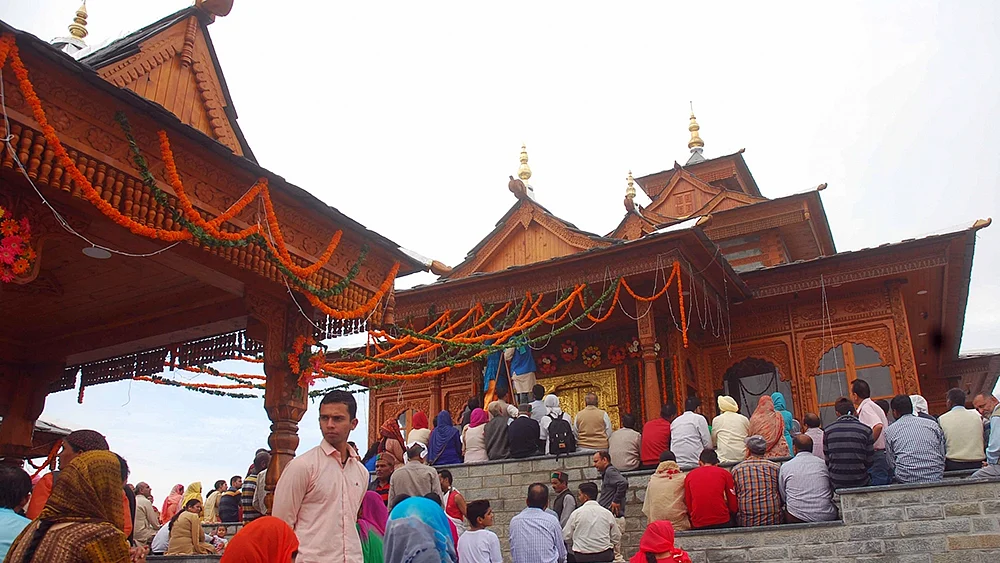Culture
Shimla’s 250-year-old hilltop Taradevi temple restored to past glory
The 250-year-old Tara Devi temple was rebuilt after three-and-a-half years at an estimate of over ₹6 crore. Intricate wood carvings have been done in ‘pahari’ style, as per the original temple

A steep road winding its way to one of Shimla's hilltops will transport tourists back to a glorious past with the rebuilding and restoration of the 250-year-old Tara Devi temple at its original location.
Perched atop a hill some 13 km from the Himachal Pradesh capital, the ancient temple has regained its glory with the past recreated in the present after a painstaking rebuilding process spread over three-and-a-half years. The statue of the Tara deity was installed there on July 20 with due rituals by 90 priests specially invited for the occasion. Now, the temple also enshrines the statues of Saraswati and Kali.
The old temple, built by the erstwhile ruler of the Keonthal estate, was demolished entirely as the wood used in its construction had weathered.
"The temple of Maa Tara has been rebuilt in its original hill architecture," temple in-charge and Sub-divisional Magistrate Anil Sharma told IANS.
He said the temple, which was restored at a cost of over Rs 6 crore, was reconstructed at its original site after the old temple was demolished.
"Intricate wood carving was done in the typical 'pahari' style as per in the original structure. Even gold and silver have been extensively used in the sanctum sanctorum after melting temple offerings," Sharma added.
The doors and the wooden structures of the temple have been tastefully decorated with miniatures of goddesses.
Published: undefined
As per state's archives, the Keonthal estate, with its capital in Junga, some 26 km from Shimla, was founded in 1211 by Giri Sen, the younger brother of Vir Sen, the founder of Suket state in Sundernagar.
The temple of Devi Tara was built by Giri Sen, whose fort still exists at Junga.
Locals say former state Chief Minister Virbhadra Singh took special interest in the temple's rebuilding as his wife Pratibha Singh, is a scion of the Sen family.
The road linking the hilltop temple with Shimla was laid for the first time during his stint as Chief Minister from 1993-1998.
"Before the construction of road, we used to trek to pay obeisance at the Tara Devi temple," Junga resident Parkash Anand Sharma told IANS.
He said even the rulers of the Keonthal estate used to travel on horseback to reach the Tara Devi temple. They had constructed huts for resting and "kuhls" or surface water channels en route.
Temple manager Anil Shandil said Virbhadra Singh, during his second stint as Chief Minister (2012-17), played a crucial role in convincing the public sector Satluj Jal Vidyut Nigam Ltd, a company that owns and operates India's largest hydropower project in the state, to contribute Rs 2 crore for the temple's reconstruction.
According to him, on an average 12,000-15,000 devotees visit the temple every weekend these days.
Earlier, the Hatu temple near Narkanda and Bhimakali temple in Sarahan—both centuries-old temples located in Shimla district—were restored after reconstruction.
Himachal Pradesh has over 2,000 temples and monasteries that are centuries-old. Of these, 60 are under the care of the Archaeological Survey of India while 36 are under the control of the state's Language, Art and Culture Department.
Officials say in total there are over 25,000 small and big temples, comprising largely local deities, dotted across the state. Most of them have been built in typical hill architecture style using wood and slate.
In the past, many temples had their own land and income generated out of it was used for maintenance and for daily prayers and worship.
The government says that after the implementation of land reforms, many temples lost their estates and, hence, income. This resulted in lack of maintenance as well as irregular worship at the temples.
The government has created a revolving fund scheme to regularise daily prayers and worship and ensure proper maintenance of the religious institutions, besides helping them increase their income.
Published: undefined
Follow us on: Facebook, Twitter, Google News, Instagram
Join our official telegram channel (@nationalherald) and stay updated with the latest headlines
Published: undefined